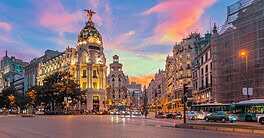Flexibility, consistent economic policies and strong regulation are some of the ingredients behind Poland’s ongoing expansion—which analysts say is likely to continue.

Last year marked the centenary of modern Poland’s re-emergence as an independent nation-state. This November, Poland will mark another, equally important date: the 30th anniversary of the end of communism and the start of its new life as a Western-oriented market economy and democratic society. As Poles mark both anniversaries, it would seem that the country, whose national anthem famously begins “Poland is not yet lost,” has found itself.
A member of the EU and NATO, Poland is as physically secure as it ever has been. The past three decades have seen impressive economic gains. Poles today are wealthier than at any time in their history. Per capita GDP in purchasing power parity rose to $31,650 in 2018, according to the IMF, and the wealth gap with the EU is steadily narrowing. Poles’ purchasing power is currently around 70% of the EU average, compared with 50% when the country joined the bloc in 2004. Unemployment is the third lowest in the EU; and public debt-to-GDP is also among the lowest in the EU, at about 52%. The fiscal deficit is around 1.7%
GDP grew 5.1% last year, according to the Economist Intelligence Unit (EIU); and analysts broadly agree that Poland’s success story will continue at a lower but still robust 3.5% in 2019, owing to slowing demand in key markets, notably Germany and the wider EU. Inflation should hold steady at around 1.1%—a two-year low—which Liam Carson, analyst at Capital Economics in London, reckons is helped by recent price declines for food and fuel.
“What makes Poland remarkable is just how well it has been doing—much better than almost any other economy—and that this success is continuing pretty much unchecked,” says Mateusz Szczurek, a former finance minister who is now lead regional economist for the European Bank for Reconstruction and Development (EBRD), which has invested over €9 billion ($10.3 billion) in 407 projects in Poland since the 1990s.
Yet success breeds its own set of worries. Carson points to wage growth, currently running at around 7% to 8% a year. Another concern is 2019’s parliamentary elections, which legally must be held by November. The ruling Law and Justice Party (PiS) is desperately hoping it will retain its majority after unexpected setbacks in last October’s local elections.
“The worry is that the government resorts to populist [economic] policies to shore up its support. and this then damages short- and medium-term confidence,” Carson says; although with around 40% of voters currently supporting PiS against roughly 30% for the opposition Civic Platform, its victory looks assured.
Canny Populists
PiS has been criticized for populist and quasi-authoritarian policies—in particular, stoking anti-immigrant sentiment and undermining the judiciary—that have antagonized Brussels and worsened the divide between the mostly rural PiS supporters and the liberal, urban opposition supporters its supporters—a split that became manifest again in the elections last October. The brutal murder in January of Gdansk’s mayor, a leading and respected member of the opposition, shows that the divisive atmosphere sometimes stoked by the governing PiS is very dangerous.
But the party has been canny, shoring up its core support via two social welfare measures. It reverted the previous Civic Platform government’s 2012 hike in the pension age to 67 (back to 65 for men and 60 for women), and introduced monthly payments for families with children. It has also committed to building up national champions in the bank and energy sectors.
Poland was the only EU country not to fall into recession after the 2008 crisis, Szczurek notes, while its fast-growing economy has distributed the benefits relatively widely. Unlike other post-Soviet Central and Eastern European countries, Poland experienced no runaway credit booms. So what’s the secret?
A big factor, Szczurek says, has been consistent commitment across all levels of government. Early intervention by the financial regulator spared many Poles from disasters like the Swiss-franc-denominated-mortgage crisis that hit Hungary in 2008. Retaining an independent zloty has helped Poland maximize its competitiveness, although the currency has remained pretty stable against the euro.
Szczurek also credits the flexibility of Poland’s private sector, the size of its market, and the highly diversified economy—none of Slovakia’s heavy dependence on autos or Hungary’s on electronics. Although foreign direct investment played an important role in the early post-communist days, subsequent investment has been driven by Poland’s domestic population, reducing exposure to global investor sentiment.
“Poland already had high levels of education and training,” Szczurek says, “but its unwavering commitment to reinforcing its links to the EU enabled it to maximize the benefits.” Government attention to infrastructure and institutional alignment with the EU, its main trading partner, have also been critical.
“The past three decades have seen the aspirations of most Poles to rejoin the European mainstream achieved,” says Gabriel Partos, Europe analyst at the Economist Intelligence Unit in London. “Poland is now very much part of the German supply chain; but equally importantly, despite its nationalist government, it is a key part of the European project.”
Attempts by PiS to cement its dominance have led to its being mentioned alongside Hungary’s Fidesz and Italy’s Five Star Movement as part of a conservative authoritarian wave in Europe. But Partos believes that the PiS’s recent compliance with the European Court of Justice in putting aside the party’s controversial judicial overhaul shows its desire to work within the EU framework.
Building National Champions
In the longer term, observers believe the nature of Polish growth will change, with manufacturers moving up the value-added chain.
“Until now, Poland has been one of the most important workshops of the EU; but with wages rising, it cannot hope to compete with China on costs,” says Partos. “There will have to be a qualitative shift—with Poland more focused on higher-tech areas—while there may also be a gradual change in the business structure, with Warsaw keen to promote national champions that can compete at a global level.”
This shift has already started. Two years ago, Bank Pekao joined PKO BP as a state-owned bank after Italy’s UniCredit sold its 59% stake to partly state-owned insurer PZU and the state investment fund. Poland’s largest energy company, the partly state-owned refiner PKN Orlen, is currently in the process of acquiring the Lotos Group oil company.
Championing national industries is controversial, given that small and mid-size enterprises (SMEs) in the private sector have been responsible for Poland’s success thus far. Yet it could help Poland trade more widely with the world beyond Europe and, not incidentally, reduce its energy dependence on Russia.
Some worry that, with its nonbank capital markets still in relative infancy, Poland may lack the infrastructure to support national champions. That is why institutions like the EBRD are focusing on helping SMEs transition into larger players with international reach.
Another concern is the continued independence and efficacy of Poland’s financial regulators. In mid-November, Marek Chrzanowski, former chair of the Financial Supervision Authority, was accused by the owner of loss-making Getin Noble Bank of seeking a bribe in exchange for protecting and supporting the bank. Chrzanowski resigned after a phone meeting with Prime Minister Mateusz Morawiecki within hours after the news broke, underscoring Warsaw’s determination to protect the regulator’s reputation.
Upcoming elections are likely to follow a glass-half-full/glass-half-empty narrative, says Partos. “When November 2019 comes around, Civic Platform will be keen to highlight the successes and distance covered over 30 years of transition; while PiS will say Poland has only really started to find itself again now, as it throws off the last vestiges of communism,” he predicts.
To voters and businesses, however, the struggle to take credit may not matter much. As modern Poland enters its second century of independence and its fourth post-communist decade, its achievements are impressive enough that the political posturing may seem like just noise.



